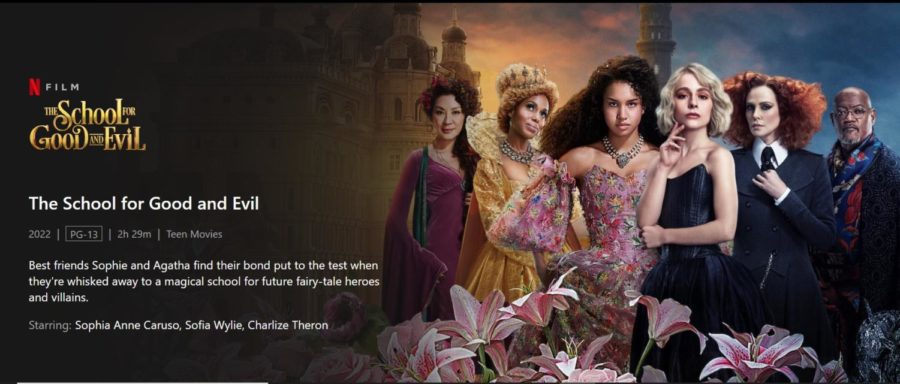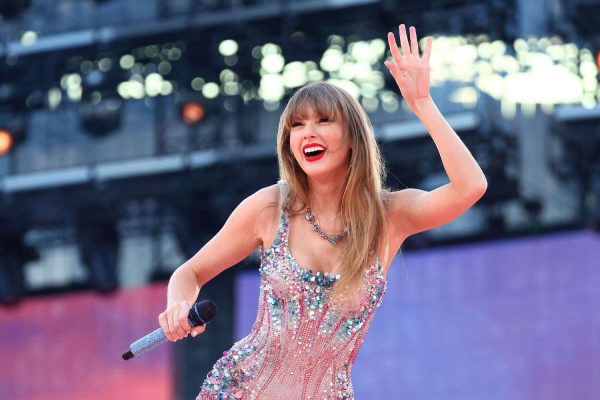School For Good And Evil Fails To Inspire
Beautiful, rich sets and creative costumes cannot save weakly developed characters
The School for Good and Evil movie, based on Soman Chainani’s New York Times best-selling book, proves again why authors should be wary of Netflix adaptations.
The movie, directed by Paul Feig, follows two drastically different teenage best friends through a whimsical fairytale world that is full of danger. Sophie (Sophia Anne Caruso) is a petite blonde fashionista who dreams of a life of greatness and importance, and she dreams of finding her happily ever after. Agatha (Sofia Wylie) is depicted as a witch by the townsfolk of their village of Gavaldon. She is brooding, lives by a graveyard and dreams of a simple life at home with her mother.
While in a bookshop together, the owner tells the legend of the School for Good and Evil, a place where average teenagers go to become the legendary heroes and villains we see in famous stories such as Cinderella and Snow White. This piques Sophie’s interest, and she wishes to be sent to the school of good to live out her dream of becoming a princess. In doing so, she also causes Agatha to be swooped up with her.
Being brought upon the school via a bird made of bones, Agatha screams of wanting to go back home, while Sophie is whooping excitedly about the new adventure. This quickly turns into horror, however, as Sophie watches the bird drop Agatha at the School of Good. She is then promptly dropped into the moat of the School of Evil.
Although the concept is interesting, it is hard to remain all that interested. The dialogue is cheesy at best. Written by award winning David Magee, it features modern quips that break the immersion provided by the fantastical way of speaking all other characters use.
Sophie says during an important, tense moment in the movie, “The protagonists are speaking.” Similarly, Agatha snaps at the narrator in a scene saying, “You know we hear you narrating, weirdo.” Dialogue pieces like these are poorly timed and fail at offering comedic relief. Tense scenes should be kept tense, and during this movie there is no such thing.
The movie also fails at creating an attachment between the characters and the viewers. The plot is rushed; therefore, there is no time for the viewers to see the main characters’ inner thoughts and motivations.
When friendships break apart and complications occur, the movie fails to pull on viewers’ heartstrings. Emotional scenes lack an impact. Despite it feeling rushed, the movie run time is an astonishing two-and-a-half hours. Characters would feel fleshed out and plot points would be hit harder if it were a series.
What the movie does get right are the costumes and the set design. The School for Good walks you through a magnificent castle covered in gold and flowers. The female students wear pompous dresses that are every shade of pink imaginable. On the other hand, the School for Evil is a dark and damp place where students wear plain black frocks and glorify uglification.
Every scene has a setting that makes you wish you were able to explore every room of each school. The sets have so much attention to detail that you can’t help but wish you could see more.
The movie also does a good job at using music to create a feeling of independence and rebellion. They use songs made by popular angsty teen singers Billie Eilish and Olivia Rodrigo to pump up the viewers and get them excited about Sophie’s beckoning to evil. Although the music does a good job at pumping up the viewer, it feels as though the adaptation is trying too hard to be modern and relatable.
Overall, the movie leaves fans of the original book with a bad taste in their mouth. The cheesy dialogue, rushed plotline and lack of impact leads to a disappointing conclusion. The movie had so much potential, but it fell flat. Once again, Netflix is taking the source material and ripping it apart, disappointing fans.







